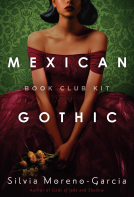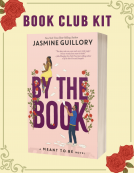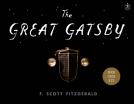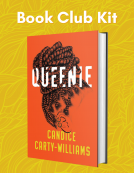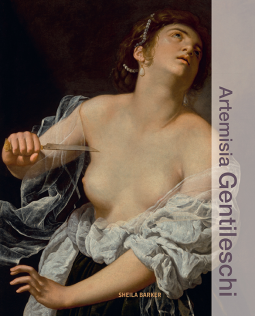
Artemisia Gentileschi
by Sheila Barker
This title was previously available on NetGalley and is now archived.
Send NetGalley books directly to your Kindle or Kindle app
1
To read on a Kindle or Kindle app, please add kindle@netgalley.com as an approved email address to receive files in your Amazon account. Click here for step-by-step instructions.
2
Also find your Kindle email address within your Amazon account, and enter it here.
Pub Date Feb 15 2022 | Archive Date Mar 22 2022
Talking about this book? Use #ArtemisiaGentileschi #NetGalley. More hashtag tips!
Description
The life of Artemisia Gentileschi (1593–after 1654) was as exceptional as her paintings. She was a child prodigy, raised without a mother by her artist father, a follower of Caravaggio. Although she learned to paint under her father, she became an artist against his wishes. Later, as she moved between Florence, Rome, Venice, Naples, and London, her artistic style evolved, but throughout her career she specialized in large-scale, powerful, nuanced portrayals of women. This book highlights Gentileschi’s enterprising and original engagement with emerging feminist notions of the value and dignity of womanhood.
Sheila Barker’s cutting-edge scholarship in Artemisia Gentileschi clears a pathway for all audiences to appreciate the artist’s pictorial intelligence, as well as her achievement of a remarkably lucrative and high-profile career at a time when few women were artists. Bringing to light newly attributed paintings and archival discoveries, this is the first biography to be written by an authority on Gentileschi since 1999.
The volume is beautifully illustrated, and Barker weaves this extraordinary story with in-depth discussions of key artworks, such as Susanna and the Elders (1610), Judith Beheading Holofernes (c.1619–20), and Lot and His Daughters (1640–45). Also included is the J. Paul Getty Museum’s recent acquisition, Lucretia (c.1635–45). Through such works, Barker explores the evolution of Gentileschi’s expressive goals and techniques.
Advance Praise
“Over the last thirty years Artemisia Gentileschi has received a good deal of attention, to which Sheila Barker’s beautifully illustrated monograph is an outstanding contribution, brimming over with fresh insights and revelatory comparisons on nearly every page . . . essential reading for everyone who has studied this artist, as well as anyone who wishes to begin to know her.” John T. Spike, author of Young Michelangelo: The Path to the Sistine and Caravaggio: Catalogue of Paintings
“Sheila Barker paints a rich portrait of Artemisia’s early career . . . providing details of the artist’s life as well as the personalities she encountered. All in all, a major contribution to our understanding of Artemisia’s life and work.” Judith W. Mann, Curator, European Art to 1800, Saint Louis Art Museum
“Sheila Barker’s book provides a compelling and lively introduction to this endlessly fascinating, complex, and essential painter whose ambitious work challenged the gender-restricting conventions of her day by asserting her claim to be the equal of her male colleagues.” Keith Christiansen, Curator Emeritus, The Metropolitan Museum of Art, New York
Available Editions
| EDITION | Other Format |
| ISBN | 9781606067338 |
| PRICE | $40.00 (USD) |
| PAGES | 144 |
Featured Reviews
Ever since I read Susan Vreeland's biographical novel about Artemisia in 2002 I have been fascinated with her life. This is a beautiful and scholarly book detailing the life of Artemisia and her work. She started painting by the age of 15 and I'm amazed so much is known about her life and works. She spends time in Florence painting for the Medici court and then continues on to Rome and to the English court. The book covers her rape and trial but doesn't sensationalize it Her marriage, moves, children, affairs, patrons etc are all part of the story as is the politics of the time. (I've been to Florence and realize there is much I don't know of the Medici history and power). I thought she was the first woman to be admitted to the Academia of Arts but this book claims that is not true. I was surprised to learn it is known for sure when she died or where she was buried. This book is as much art appreciation with focus on elements and interpretations of what the artist creates. I confess I find that harder to read because it is subjective.
This book is put out by Getty and includes her art and some others works for comparison. It is a second in a series about Women Artists. I think it would be great for anyone interested art of the 17th century or in Artemisia herself. As I mentioned it is scholarly and would not be easily read by younger readers. I'd recommend high school and up. My daughter would have loved this when she took AP Art History. Because so much of her work is in private collections I feel lucky to have seen at least 15 in my travels in Europe and the USA. Thank you to NetGalley and Getty Publications for a temporary eARC in exchange for an honest review.
 Nightwing W, Reviewer
Nightwing W, Reviewer
One of the best books I have happened across about Artemisia Gentileschi. She seemed so real and "here", I expected to see her sitting on my bench in my yard. A great book for anyone who loves Art.
An engaging read, beautifully illustrated, detailing the fascinating life of the artist
Artemisia Gentileschi her life would be a fascinating subject to a historical fiction (imagine Hilary Mantel taking on this life of a female artist moving through the papal court, the Medici at their height and the English royal court, with a missing husband and successful court case against her rapist).
Sheila Barker takes on the subject in a scholarly manner, going from the youth of the artist through to her successes, that eclipsed the fame of her painter father.
The interpretations of her pictures as very much engaging with political and theological machinations is sometimes both imaginative as stretching the credible, certainly taking into account that Artemisia was not a formally educated person. Still this makes the reader see the many Maria's and the many female nudes in a different light. Along the way we get to see beautiful combinations of purple and yellow and theories of the photo-feminism of the artist.
An engaging read, full of enticing works, good as an introduction to the work of the artist and baroque art in general.
I have seen some of this artist’s paintings and was fascinated by them. Here was a woman painter at a time when the art world was dominated by men. Plus, I later learned about her complicated personal history. For these reasons, I was delighted to have the chance to see this book and to learn more about AG.
This title is published by Getty and they clearly know how to produce gorgeous books on art. This book is part of a series on female artists and is motivated, in part, by current social movements and the desire to give space to past pioneers. Each book, according to the introduction, looks at a female artist in terms of social, cultural, temporal and geographic contexts. Attention is also paid to the artist’s life story and the growth and evolution of their art.
The reproductions in these pages are plentiful and provide a good sense of the artist. I loved many of the Madonna and Child portraits which, to me, exhibited a contemporary (to her time) feeling and a sense of the warm relationship between the two.
Art lovers and those who want to enhance their knowledge base will enjoy this title. I definitely recommend it.
Many thanks to NetGalley and the publisher. All opinions are my own.
 Christine E, Reviewer
Christine E, Reviewer
Disclaimer: I received an ARC via Netgalley
Barker’s short book about Gentileschi is part biography, part art appreciation. Barker focuses more on Gentileschi’s art and how it was influenced by or touched on the politics of the day, be it working for the advantage of Catholics in England or endorsing female power in her native Italy.
Artemisia Gentileschi’s most famous painting might be either her painting of Judith Slaying Holofernes or Susanna and the Elders Many people know her simply as the woman Italian painter who got raped and then did pictures dealing with women killing men or about rape itself.
This does her a disservice.
Barker’s book corrects this. The rape and its, possible, connection to some of her work is addressed but is not the center of the book. Gentileschi’s work itself is the center as well as how the work relates to the larger political world that Gentileschi inhabited during her lifetime (1593-1656). It is a quick and interesting read. Despite its short length it is full of information not only about the painter and her personal biography, but also of the time and how women artists operated or succeeded during the time. Additionally, Artemisia is placed alongside the other members of her family who produced art, not just her father who she is usually mentioned alongside, but her brother as well. There is even some information about her mother.
Some reader might want a bit more biographical detail, in particular in regards to Gentileschi’s relationship with other women, but considering how scant some of the details of her life are, perhaps this into possible. Barker does include a list of sources for further reading at the end.
This book is ideal for anyone who is just starting to learn about art or Gentileschi.
Artemisia has had a warm place in my heart since I first learned about her incredible art and life in my AP Art History class my senior year of High School. This well-researched volume takes a deep dive into her life and artwork creating a comprehensive biography of sorts. The author spent a lot of time in the archives in Florence seeking traces or Artemisia’s life and it shows in the book. The book provides both bibliographical information and analysis of the art. The information in the text was very well written, but was so well researched that it grew tedious, and I found myself skimming several sections. I really appreciated that the book included large full color illustrations of Artemisia’s work as well as similar pieces from contemporaries for references. I think this is a great reference book for Art History scholars, but will likely be too much information for the casual art lover.
Artemisia Gentileschi has been unjustly overlooked throughout history and lately seems to be getting the recognition she deserves. This gorgeous volume does its part, with an original look at her life and work. The author doesn’t just enumerate all her paintings and include a biography, but integrates both in an approachable narrative. She focuses on some of Artemisia’s paintings and the most significant issues that affected her art (such as her religious views and interest in writing sonnets). The volume includes a sample of Artemisia’s paintings, as well as some of her influences, in photographs of outstanding quality. Sheila Barker is an authority in Artemisia Gentileschi, and it shows. What I liked the most is how the book shows the painter’s legacy to feminism, but based on her own time, not ours. All I knew about the artist is that she had been raped, but she was no victim, she lived a rich and independent life and Barker makes this clear. This is a great book for art lovers and anybody interested in learning more about Gentileschi and her time.
I chose to read this book and all opinions in this review are my own and completely unbiased. Thank you, NetGalley/#Getty Publications!
 Tammy B, Reviewer
Tammy B, Reviewer
Tremendously Interesting and valuable. As this is a scholarly work, I (no art scholar, I assure you) am probably not the most qualified to review it, That said, I was able to follow it with great enjoyment. And the illustrations were nothing short of magnificent.
Thanks to NetGalley for providing an ARC copy for my review.
This comprehensive overview of Artemisia Gentileschi's life and influences is spectacular. I knew a bit about this incredible artist through her paintings as well as through a book of historical fiction about her life. This is the first time I felt I have a much better understanding about her life, her influences and Renaissance society during her time. Others have written fragments about her life (most notably about her rape by an older artist). This book changes the frame to examine how she stood with respect to society's views of womanhood. She had many other women role models - including Lavinia Fontana, a female artist in her own right, who I am chagrined to say I had never heard of until this book! Artemisia's art depicts female nudes in empowering and realistic ways. This book provides beautiful reproductions of her work (among others such as art by her father', Caravaggio, and Fontana) This is a beautiful comprehensive tribute to a great artist who deserves this long overdue recognition.
Artemisia Gentileschi is a new name for me, sort of. I know I didn’t study her paintings when I was in high school, and that I found out about her a few years ago, thanks to a Tumblr post. I’m sure I have it saved somewhere because it was interesting: it talked about Susanna and the Elders, about how the original drawing was more vivid, harsher.
Now I can’t remember if the last version was painted over the previous one or what, but I studied the composition for a while. Gentileschi sense of movement—of life?—is impressive.
**
The life of Artemisia Gentileschi (1593–after 1654) was as exceptional as her paintings. She was a child prodigy, raised without a mother by her artist father, a follower of Caravaggio. Although she learned to paint under her father, she became an artist against his wishes. Later, as she moved between Florence, Rome, Venice, Naples, and London, her artistic style evolved, but throughout her career she specialized in large-scale, powerful, nuanced portrayals of women. This book highlights Gentileschi’s enterprising and original engagement with emerging feminist notions of the value and dignity of womanhood.
Sheila Barker’s cutting-edge scholarship in Artemisia Gentileschi clears a pathway for all audiences to appreciate the artist’s pictorial intelligence, as well as her achievement of a remarkably lucrative and high-profile career at a time when few women were artists. Bringing to light newly attributed paintings and archival discoveries, this is the first biography to be written by an authority on Gentileschi since 1999.
The volume is beautifully illustrated, and Barker weaves this extraordinary story with in-depth discussions of key artworks, such as Susanna and the Elders (1610), Judith Beheading Holofernes (c.1619–20), and Lot and His Daughters (1640–45). Also included is the J. Paul Getty Museum’s recent acquisition, Lucretia (c.1635–45). Through such works, Barker explores the evolution of Gentileschi’s expressive goals and techniques.
144 pages
Biography, nonfiction
Getty Publishing
Goodreads
**
Cover: Oh. Hm. Good painting choice, but the left stripe ruins it. A different font and a different color, sans stripe, would have worked better.
Yay!
- As I mentioned above, Gentileschi’s works haven’t been that widespread in the past, at least in my neck of the woods. Being able to read her biography is a gift, even more so because it’s a good one: well-researched, full of details, and not focusing on the grim aspects of her life. It would have been easy to go for the shock value of her assault, something Barker steered clear of. Thank you.
- There’s an ample choice of paintings, going from the most famous ones to the lesser-known. As always, it’s hard to admire art on a screen, but the pictures look crisp and taken with an eye for details.
Engaging prose, mixing both Gentileschi’s life and other painters’—same with their works. I will not lie, I’m in two minds about it. However, Barker makes it easier for us to compare Gentileschi’s style with different ones.
- Gentileschi’s best feature is her sense of movement, something Barker highlights. Her paintings aren’t static; rather, they look like snapshots, taken in the middle of action. The fact that her talent is being recognized worldwide puts an emphasis on it: you thought Caravaggio was the master of movement? He has to share the title with Gentileschi, sorry.
- I like mistake-free books! I always want to high-five my fellow editors when they do a good job—it’s important.
Special mention:
- Allegory of Inclination
- Judith Beheading Holofernes (the sense of movement and the fact Gentileschi didn’t pull any punches render this one astounding)
- Judith and her Maidservant with the Head of Holofernes (I never saw this painting before)
- Susanna and the Elders
- Self-portrait as the Allegory of Painting
Nay!
- I’m not sure about having other artists featured in the book. While I can understand and, to a point, appreciate that choice, Artemisia Gentileschi is a book about Gentileschi. She didn’t live in a bubble, but the spotlight should be hers.
TL;DR
4 stars on GR.
Artemisia Gentileschi (Illuminating Women Artists) is a laudatory, panegyric on the life and times of this remarkably talented Baroque artist. This biographical monograph is the second book of the sub-series of Illuminating Women Artist: Renaissance and Baroque, by Sheila Barker. In Artemisia Gentileschi, Barker has produced an authoritative account of the artist that is appropriate for knowledgeable art enthusiasts and those with an academic interest.
To read the full review visit. litercurious.com
This is a biography of Artemisia. I had never heard of Artemisia. Therefore, this was a very eye-opening biography. This book was also very balanced and comprehensive to the general reader. Therefore, I recommend this for those interested in women artists!
This really was an amazing book. When I asked for this book I had never heard of this artist and I am sk glad I got it as I thoroughly enjoyed reading it. It was so fascinating and the artwork was stunning. What I found so amazing about this artist was her use of colour to bring out the importance of each piece of artwork. Also how well she portrays the female form and the power held within women. This author did a fantastic job of getting across how amazing this artist was. With such knowledge and explained in a wonderful yet easy to understand manner, as I am not an artist myself.i just appreciate art and find such beauty in its many forms. I am so glad that I had found this book as I have learnt so much and have benefitted so much from reading it. By the end I was truly in awe. I really can't recommend this book enough to all artist, students and art enthusiastic out there.
So much praise goes out to the author and publishers for putting this wonderful book packed full of amazing information and stunning pictures, that were extremely thought provoking.
The above review has already been placed on goodreads, waterstones, Google books, Barnes&noble, kobo, amazon UK where found and my blog https://ladyreading365.wixsite.com/website/post/aetemisia-gentileschi-by-sheila-barker-getty-publishing-4-stars either under my name or ladyreading365 or lady Reading365 or ladyc reading
 Reviewer 213851
Reviewer 213851
Sadly not much is known about many female artists, especially the further in time you go back. Artemisia Gentileschi is no exception, but we are able to get as much as we can from this book. While information on her later years is still unknown, this book gives us context of what it was like for female artists of her time, who came before her, and what her life was like, along with many depictions of her works, her fathers, and others to give more context.
Great read for those interested in art and or women of history. CW- Artemisia was raped. This unfortunate event does play a major role in her life, including a trial.
 Librarian 784227
Librarian 784227
Artemisia Gentileschi is a concise version of the story of one of the few well-known and acknowledged female artists of the Baroque era. This book traces her early years, her success under the Medicis, and her motivations and missteps. Included many examples of her work as well as some of the works that inspired and influenced her.
 Lindsey D, Bookseller
Lindsey D, Bookseller
This is a very comprehensive story of Artemisia Gentileschi, with wonderful full color prints that will appeal to those coming from an art background or just casual interest in the artist. The same goes for the information included. It's definitely a triumph in making information about female artists from centuries ago more easily accessible. It can be dry at times, but I prefer that to the alternative of playing up the more salacious aspects of her history.
 Lesley D, Reviewer
Lesley D, Reviewer
I can recommend this book highly for readers familiar with Gentileschi and for those interested in the life of a gifted woman painter who triumphed over terrible circumstances. The plates are beautiful reproductions of her work and the the writing is compelling.
An incredibly engaging, thought-provoking, and researched volume detailing the life of Artemisia Gentileschi. Sheila Barker went beyond the surface that authors are usually able to dedicate to Gentilschi and brought her to life as a individual that actually lived. I found it hard to read at times, but I am out of practice with nonfiction so that is likely on me rather than Barker. Incredible reproductions as well.
**Big thanks to NetGalley and the publisher for an eARC copy in exchange for an honest review.
“Artemisia Gentileschi”
By: Shelia Barker
The Extraordinary Life, and Breathtaking Art, of Artemisia Gentileschi, a 17th Century Italian Woman Genius
During of the Italian Baroque Period of the 1600s, proper young women were only seen in public when accompanied by chaperones and were forbidden pursuits then only available to boys and men.
We learn, however, in the biography, “Artemisia Gentileschi,” by Shelia Barker that Artemisia, the eldest child and only daughter of Prudenzia di Ottaviano Montoni and Tuscan painter and muralist Orazio Gentileschi, was learning to draw; grind ultramarine and other pigments; and develop her own drawing and painting techniques while working in her father's studio from her earliest childhood days.
A child prodigy, Artemisia learned and advanced rapidly in her burgeoning skills. She quickly advanced in wide ranges of artistic techniques. Her works were soon sought throughout Europe by the greatest of art patrons and collectors—from Medici’s to Kings.
Reviewing Artemisia's art in the biography, we see her mastery of chiaroscuro’s dramatic light and dark highlighting techniques made famous by Rembrandt and Caravaggio; her sensitivity and anatomic accuracy in line drawing studies (see example of female lute player hands) similar to DaVinci studies; and genius at painting sumptuous female figures in vibrant, physically and emotionally realistic ways that are initially like contemporary Caravaggio, who was probably the most influential painter of the day—known by many as the father of the Baroque Art Movement.
The highest praise possible goes to Shelia Barker for sharing the life and art of Artemisia Gentileschi with the world. Artemisia was a true “renaissance woman” in the sense that she was light-years ahead of her time—a feminist trail blazer when women were seen and not heard—definitely not competing with the “best of the best” at their own game—Art!
Barker’s beautifully written story of Artemisia’s life and art is fully illustrated. Readers are treated to page after page of crisply reproduced Getty Images color prints of Artemisia’s works. Artemisia’s art is a feast for the eyes, as well as the soul, because its lush evocativeness is truly transformative.
=====================///=======================
The Book Maven’s Journal—Reviews for Word Connoisseurs
REVIEWER: J.Hunt
STAR RATING ⭐️⭐️⭐️⭐️⭐️
“Artemis Gentileschi ”
Author: Shelia Barker
Genre: Art & Photography | Non-Fiction | Biography
Publication Date: 14 February 2022
Publisher: Getty Publications
With Sincerest Appreciation to NetGalley, Author Shelia Barker and Getty Publications for Providing this Advance Reader’s Copy for Review.
 Reviewer 492564
Reviewer 492564
This is a well-written intro to the life and works of artist Artemisia Gentileschi, complete with scholarly text and excellent illustrations, The text isn't so scholarly as to make it difficult to read, and it offers an overview of the history of criticism and biography on Gentileschi that will be helpful to anyone interested in her work.
 Sierra B, Reviewer
Sierra B, Reviewer
Very interesting, short book on a fascinating woman. This would pair well read after Blood Water Paint, a novel in verse about Gentileschi. The paintings in my digital edition are high quality and well-placed in the text.
 Leslie G, Book Trade Professional
Leslie G, Book Trade Professional
Balanced and informative about a great artist with beautiful illustrations throughout. While I do not know if there is a lot new about. Artemisia’s life, it was certainly new to me - and I appreciated learning not only about her enterprise and skills, but also the contexts of her life - including role models who were musicians and artists too - using their female wile to find their ways. It is plainly and directly told with no ‘defensive’ edges about her being an early feminist - among many others I discovered. More a biography of a time than about the aesthetic techniques of the artist … wonderful.
 Librarian 431790
Librarian 431790
Artemisia Gentileschi is a sort of "feminist icon" in Italy since Anna Banti wrote about her life in a book that is considered a masterpiece of XX century.
She was a great painter but somehow she's more known for the rape and the trial.
This well researched and comprehensive book help to discover more about Artemisia and her works.
It's not an easy read but it was very interesting.
Highly recommended.
Many thanks to the publisher and Netgalley for this ARC, all opinions are mine
Coming to know Artemisia Gentileschi as a feminist icon, I was in awe at the rich information this book provided! It's truly a must read for anyone who wants to understand the life and work of this extraordinary woman.
It offers context and perspective to her times and actions and how she exceeded the position usually women held in those specific times. It brings a complex and abundant view of her works, the themes she painted and how she portrait them, especially the nude, ever so present in her paintings.
My only complaint is the author wanted so much to bring into light her work and her determined ways that it left little space to her personal life after marriage, especially as her lover was barely mentioned. She specifically gives reason for this, but I feel a bit more than simply mentioning him would have been more helpful to understand Artemisia's life even deeper.
Nevertheless, this book answered so many of my questions and I find it very valuable for not only knowing more about Artemisia but offering many pieces of evidence to her extraordinary skills, determination and character. Loved it!
I received a copy of this book in exchange for my honest opinion.
Artemisia Gentilesch’s newly restored painting Judith and Her Maidservant with the Head of Holofernes will be the centerpiece of the Detroit Institute of Art’s 2022 exhibit By Her Hand: Artemisia Gentileschi and Women Artists in Italy, 1500-1800. I already have our tickets!
I first learned of this artist in Susan Vreeland’s novel The Passion of Artemisia. I was curious to gain a deeper understanding of her art before viewing the exhibit.
Sheila Barker’s book Artemisia Gentileschi provided me with an excellent biography and critical insight into Artemisia’s work.
This book is part of Getty’s Illuminating Women Artists: Renaissance and Baroque, a series which “considers early modern women artists within their social, cultural, temporal, and geographic contexts.” Barker notes that much has been written about Artemisia Gentileschi over the centuries, beginning in her lifetime. And yet, there are “large voids” of unknown time in her life. “How Artemisia stood with respect to her society’s view of womanhood is…one of the main questions driving this book,” the author notes.
Considering the social constraints that women had to live with in the 16th c, it helped that Artemisia’s father, Orsini Gentileschi, was a successful artist, and their relationship was likely closer due to the early death of her mother. Her gift was first identified when she designed and embroidered an elaborate design on a skirt.
She likely first learned to paint by observing her father painting. I can imagine it as my mother took up oil painting when I was six or seven and I watched her as she explained how she mixed the oil paints and worked on her paintings. Mom soon set me up to do my own painting.
The art of Caravaggio was revolutionary, and father and daughter studied his methods together, painting on a dark ground.
The teenage Artemisia was raped by another artist, Agostino Tassi, who made false promises to keep her silent. Nine months later, Orazio took Tassi to court and Artemisia defended herself in the trial. Her father soon married her off, making sure she kept control over her dowry. Her husband’s family expected that Artemisia as an artist would generate the money for the family.
Artemisia’s history paintings depicted Biblical females, including Susanna and the Elders, the story of a young woman bathing in her private yard while lecherous men watch. It is chilling to think of her painting the story of rape, herself a victim. She also painted the virgin Mary, Judith Beheading Holofernes, Mary Magdalene, Bathsheba. The themes allowed her to show the female body and women who were strong and capable and spiritual equals.
Artemisia relocated from Rome to Florence in 1613, her husband a citizen of Florence. She hoped to become a painter for the Medici court. It was a difficult time; she lost a newborn baby, didn’t have a proper studio, and was intent on replicating Caravaggio’s style. She was aided by family, gambling on her artistic promise. By 1614, she was working on three paintings for Cosimo II. One was a self-portrait.
Her patrons include Michelangelo Buonarroti the Younger who commissioned her Allegory of Inclination, another facial self-portrait, showcasing her ability on depicting the female nude.
By 1619 she and her husband appear to have been living apart and she assumed fiscal and legal responsibility for herself.
The Grand Duke had planned for his wife and mother to become regents for his underage son upon his death. He needed to bolster the public’s acceptance of female leadership and so promoted ideals of strong women leaders. In her art, Artemisia’s women, therefore, were also political renderings.
Artemisia traveled to Venice and finally to London where her father had been painting for the court of Charles I. With the English Civil War and the death of Charles I, his art collection sold off, some of her art was lost. One work created during this time was her Self-Portrait as the Allegory of Painting and the political Esther Before Ahasuerus.
I will show your Lordship what a woman can do…You will find the spirit of Caesar in this soul of a woman…”
Letter from Artemisia Gentileschi to her patron Don Antonio Ruffo
I was impressed by this resilient, strong female artist. Barker’s analysis of the paintings were extremely enlightening and I know that when I see the exhibit, I will have a deeper appreciation.
I was given access to a free egalley by the publisher through NetGalley. My review is fair and unbiased.
 John L, Reviewer
John L, Reviewer
Suitably well-produced, this acts as a fine introduction to Gentileschi's life and output – or should that be Artemisia's, for our author insists on using just her first name to differentiate her from her father, who also gets the less formal forename-only address. I'm not exactly a fan of dusty old religious paintings, however much nudity the situation (or purchasers) demanded, but even I can see the life in these women, the dynamism in their physicality, and the eye-catching status of the moments captured on canvas. It goes a long way beyond being a simple primer, for I don't think many casual browsers will want all the information about where she was living, or who was paying her way, or what royal eye she was trying to turn with a self-portrait. The centuries, too, have not been too kind to her life story, leaving large gaps in what we do know (how and when her husband disappeared, where her remains are, unheralded to this day, and so on). So some will find the forensic detail at times too much, and the basics and intrigue of her life sorely missing. But that art? The years have been very kind to it, for it looks as fresh as new, and her prodigious craft ever-evident. I was aware in rating this book so highly a lot of that was down to Artemisia herself, but this volume does deserve a lot of appreciation as well as its subject. Four and a half stars.
Artemisia Gentileschi by Sheila Barker is the second volume in the Illuminating Women Artists series from Getty Publications and is an informative and beautiful addition.
Though one of the better known women artists of the past Gentileschi is still mostly known in outline by casual art lovers. This book serves to tell both her life story and her artistic development in as coherent a manner as possible. I found the weaving of her personal life, the society in which she lived, and her artistic response to both absolutely intriguing.
There is enough biography here to satisfy those wanting to know more about the artist yet there is plenty of art history and analysis to satisfy those mostly interested in the art itself. Shedding more light on the often overlooked and/or ignored women artists makes this a series to keep an eye on. I have been pleased with both volumes so far.
Reviewed from a copy made available by the publisher via NetGalley.
Readers who liked this book also liked:
Silvia Moreno-Garcia
Historical Fiction, Literary Fiction, Sci Fi & Fantasy
